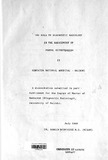The Role Of Diagnostic Radiology In The Management Of Portal Hypertension In Kenyatta National Hospital - Nairobi
Abstract
A retrospective and prospective study of 50 patients wfth portal hypertension was carried out at Kenyatta National Hospital (K.N.H.), Nairobi,
from November 1980 to November 1985. Patients were
classified into five aetiological categories on the basis of clinical, histological and radiological data. Their age, ~ex, ethnic group, aetiological
and geographical distribution were analysed.
Portal Hypertension affected a generally younger age group (mean 24 ..3 years). The overall
sex ratios approximated the normal male:female 1.4:1
ratios of KNH and the Kamba were found to predominate most aetiological categories. Over 60% of the patients in the study had their residence ln the Eastern
Province. The role and relative merits of ultrasound
and other radiological investigations in influencing patient management is disscussed.
While splenoportovenography proved to be the single most influential radiological investigation, particularly in deciding between the surgical or
medical management of the patients~ teal time ultrasound showed potential as a rapid, .simple non-invasive
screening technique for these patients. The lack
of splenic and superior mesenteric vein swelling, which is always present in the normal subject during the Valsava manoeuvre appeared to be the most sensitive
criteria for ultrasonic diagnosis of portal hypertension.
Both endoscopic injection sclerotherapy and shunt surgery in carefully selected patients proved to be equally successful in improving the quality of the patients life keeping it relatively free from life threatening haemorrhage in the one year follow up period. Proposals for a more rapid, accurate
diagnostic and management protocol are made.
Citation
Master of Medicine (Diagnostic Radiology),Publisher
University of Nairobi. College of Health Sciences

